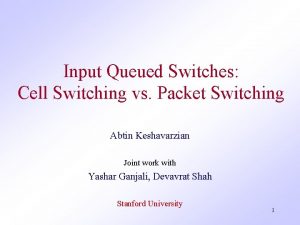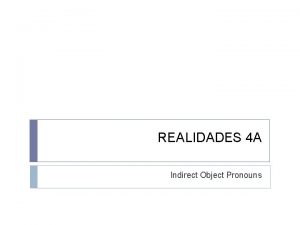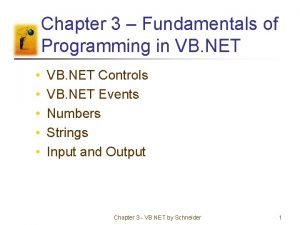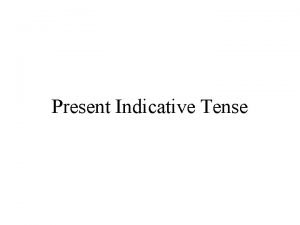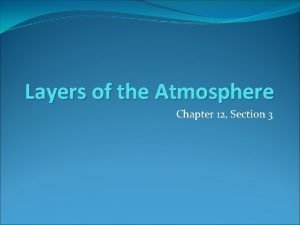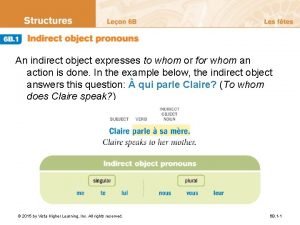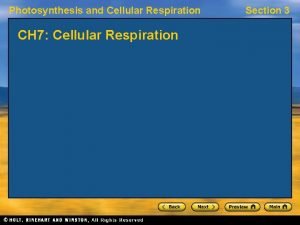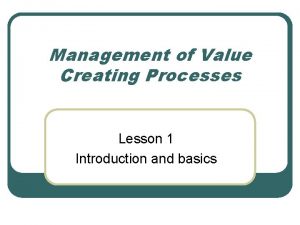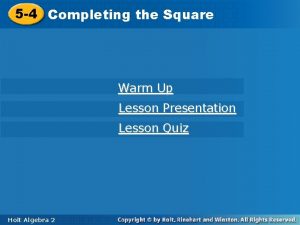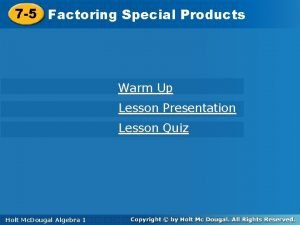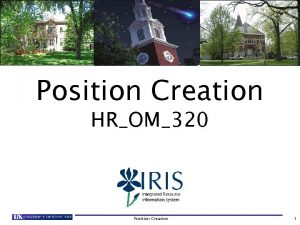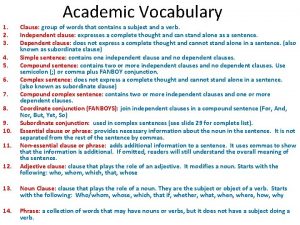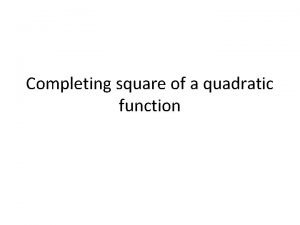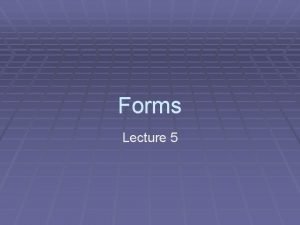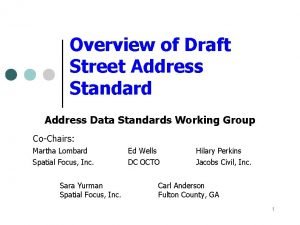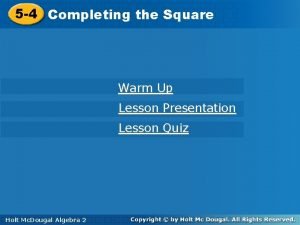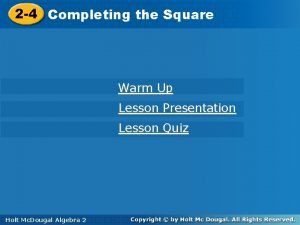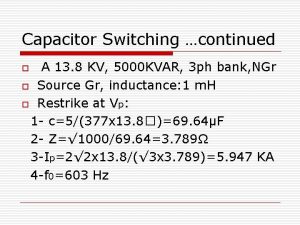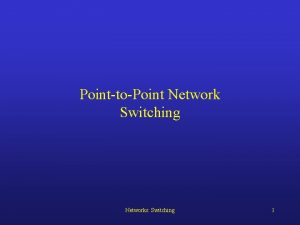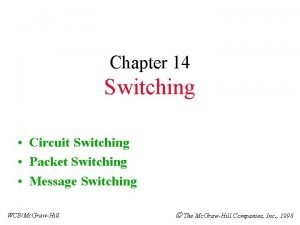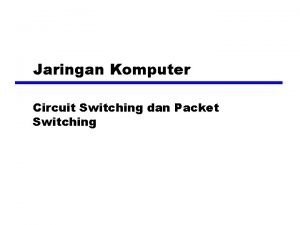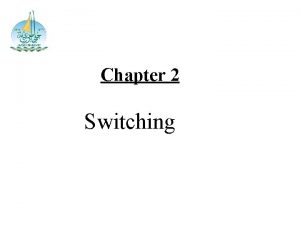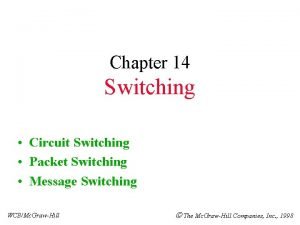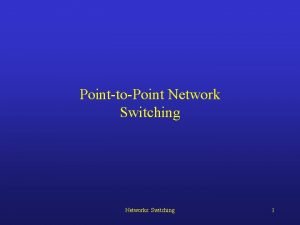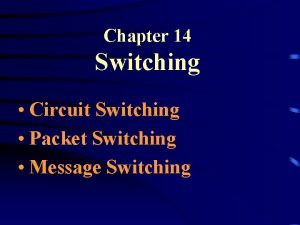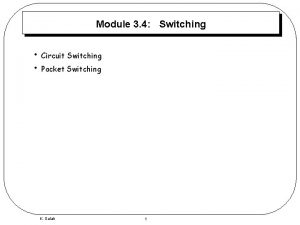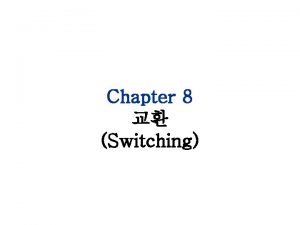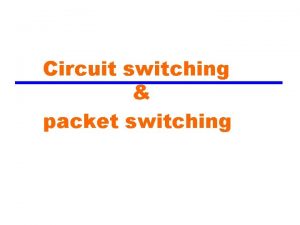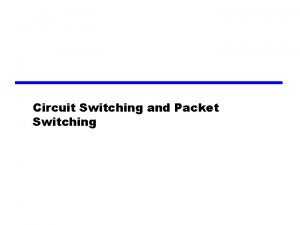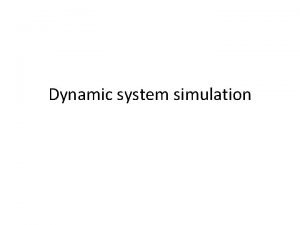Capacitor Switching continued A 13 8 KV 5000


























![Q 3 continued o o o o V’c(0)=-Vc(0)/RC-IL(0)/C, Vc(0)=0 vc(s)=-IL(0)/{c[s^2+s/RC+1/LC]} without R -IL(0)/c x Q 3 continued o o o o V’c(0)=-Vc(0)/RC-IL(0)/C, Vc(0)=0 vc(s)=-IL(0)/{c[s^2+s/RC+1/LC]} without R -IL(0)/c x](https://slidetodoc.com/presentation_image/a7afd99ec0c6a5483a374844f3756a0b/image-27.jpg)



- Slides: 30

Capacitor Switching …continued A 13. 8 KV, 5000 KVAR, 3 ph bank, NGr o Source Gr, inductance: 1 m. H o Restrike at Vp: 1 - c=5/(377 x 13. 8�)=69. 64μF 2 - Z=√ 1000/69. 64=3. 789Ω 3 -Ip=2√ 2 x 13. 8/(√ 3 x 3. 789)=5. 947 KA 4 -f 0=603 Hz o

Subsequent Occurences o o o C. B. Interr. H. F. current at its zero: 3 Vp on Cap. &at most 4 Vp across C. B. If 2 nd B. D. occur, 2 nd Osc. I doubles, Vc from +3 Vp to -5 Vp: If C. B. opens, at most 8 Vp across C. B. further ESCALATION possible Rs: seq. Restrikes, Cs: subseq. Clearing Variation of VCB shown in FIG

Other Restriking Phenomena o Seq. restrik. & clearing of C. B. O. V. s (even inductive load) low p. f. results in Vp at zero current Dominant f. TRV=ω0/2Π= 1/[2Π√L 2 C] ; Fig. o Several KHz if C stray Cap. small o o o o reigniting effect; heuristic approach: Superposition of : Vs(0) effect + Vc(0) effect I=Vm/[ω(L 1+L 2)] sinωt I 1(0)+I 2(0)=I(0)≈I’t(during short duration) I’= Vm/[L 1+L 2]

Restriking cct: reignition after isolating inductive load o Equivalent CCT Short interval ∆t 0 source sub. Battery o I 1&I 2 rising ramp o o as current restab. Ramp component 1: Vs(0). t/[L 1+L 2] f 01=1/2Π x {√[L 1+L 2]/L 1 L 2 C}

Discussion Continued …. Now superposing effect of the Capacitance Initial Voltage Vc(0) at reignition: Surge impedance: Z 0=√{L 1 L 2/[c(L 1+L 2)]} o The Osc_component 2: Ic=Vc(0)/√{L 1 L 2/[c(L 1+L 2)]} o fraction L 1/(L 1+L 2) of it pass L 2 o fraction L 2/(L 2+L 2)of it pass L 1

Formal Solution o o Two Loops Equation: L 1 d. I 1/dt+Vc(0)+1/c∫(I 1 -I 2)dt=Vs(0), (1) Differ. (1): d�I 1/dt�+I 1/L 1 C-I 2/L 1 C=0, (2) Vc(0)+1/C∫(I 1 -I 2)dt=L 2 d. I 2/dt, (3) L. T. of Eqs (2) & (3) respectively: (s�+ω1�)i 1(s)-ω1� i 2(s)=s I 1(0)+I 1’(0) (4) ω2�i 1(s)-(s�+ω2�)i 2(s)=s. I 2(0)+I’ 2(0) o o I’ 1(0)=Vs(0)-Vc(0)/L 1, I’ 2(0)=Vc(0)/L 2 ω1�=1/L 1 C, ω2�=1/L 2 C (5)

Discussion of Formal Solution o o o Solving Eqs (4) & (5) simultaneously yields current 2 comp. s: 1 - a ramp component 2 - a damped oscillating component with: √(ω1�+ω2�) =√[(L 1+L 2)/L 1 L 2 C] In first method assumed I 2(0)=0 true if Reignite at peak of TRV sys Gr Neutral, this fault High Cur. & cause Damage All sys Gr directly or through some stray C So: “ARCING Gr” Next Discussion

ARCING GROUND o o o o L-Gr fault: arc; ph & Gr stop&Reig. repeated Fig of simple model without sources C 1 : ph to ph cap. C 0 : ph to Gr cap. N at Gr potenial A to Gr shift V; Ep=1 pu VA neg. peak at F. instant Shift shown in phasor D.

Discussion of Arcing Gr. results o o o C 0 of A discharge; N rise to Ep & B, C rise C 1&C 0 share charges at B and C not at once to Diagram values Charge Conservation: V(C 0+C 1)=1/2 C 0 Ep+3/2 C 1 Ep V=Ep/2[(C 0+3 C 1)/(C 0+C 1)] VB&VC rise to 3/2 Ep osc. C 0, C 1&Ls CCT shown in Fig.

Discussion Continued … Equivalent CCT o o o f 0=1/{2Π√ 3 L(c 0+C 1)} Z 0=√{3 L/4(C 0+C 1)} VB&VC above 3/2 Ep Ip=(3/2 Ep-V)/Z 0 subs. for V&Z 0: Ip=2 Ep(C 0/C 0+C 1)x □ □ √{(C 0+C 1)/3 L} IB pass out of node B divided: Ic 1, Ic 0 Ic 1 pass the arc; its frac. : C 0/(C 0+C 1) □ Also a 60 Hz current due to VA through CN

What Happens Afterward? o o Depends on Arc behavior: 1 -Iarc till next p. f. zero in 1/2 cycle 2 -Iarc immed. Ceased in 1 st zero of the IHF If 1, occur : after ½ cycle; since A is still at Gr level; N in -1 pu 3 ph Phasors in next Fig a N keeps -1 pu and after 1/2 cycle: VA rise to -2 pu Fig b

Phasor Diagram after interrupting a reignition current o o o Fig a & b If Reignite again : similar shift ∆V=2 pu Rather than 1 pu Transients higher N -1 pu Swings of A & B Then seq. can repeat

continued on case 1& then Case 2… o o o after 1/2 cycle A, Gr however at +peak B&C instant. -1. 5 pu to Gr If now arc interrupts VN change -1 pu After ½ cycle exactly as last fig b Case 2 : If interrupt at 1 st zero of IHF occur at point P of curves 1 -Vc 1, Vc 2 attain Vp 2 -Arc extinguish C 1 s rise to VLL(VAC=VAB=1. 5 pu) o Vp=1. 5 Ep+(1. 5 Ep-V)=3 Ep-V

Continued on Case 2 i. e. Vp-3/2 Ep=3/2 Ep-V across arc path □ N has corresponding Disp. □Phasor Diag. Fig. a □different from 1 st fig □Then arc interruption at p. f. current zero when Vmax=VAG, 1/2 cycle later, situation of figb

Discussion o o o transient following next reignit. Is greater Arc is interrupted in 1 st H. F. zero I neutral displacement increases increase in energy trapped on zero seq Cap escalate the voltage How to suppress arcing Gr OVs: 1 - an appropriate reactance in neutral 2 - Peterson coil , sensitive for fault detection

Assignment No. 3 o Ques. 1: o C 1=2μF, C 2=. 38μF L=800μH, R=5Ω o VC 1(0)=75 KV o S closes, compute 1 -Max energy in L? 2 -t 0 instant current flow in c 2 3 -Vc 1(t 0)? 4 -Max of Vc 2 ? o

Solution of Question 1 o o o Z 0=√L/C 1= √ 800/2=20Ω S close: Ipeak(undamped)=75/20=3. 75 KA λ=Z 0/R=4(fig 4. 4) Ip=0. 83 x 3. 75= 3. 112 KA Emax=0. 0008 x 3. 112^2/2=4. 12 KJ I flows in C 2 when reverses fig 4. 4 at t’=3. 15 or t=3. 15√LC 1=126μs, (T=40μs) fig 4. 6 Vc 1=-0. 69 x 75=-51. 75 KV

Eq. CCT (Diode goes off) o o series RLC CCT At this instant: Vc 1(0), Vc 2(0) required o o CCT diff. Eqs employed Solved for Vc 2

Solution of Question 1 continued o o 2 nd 1/2 cycle, Vc 1(0)=51. 75 KV, Vc 2(0)=0, I(0)=0 C 1&C 2 now in series Ceq=C 1 C 2/(C 1+C 2) Z 0’=√(800 x 2. 38)/(2 x 0. 38)=50. 05Ω λ’=50/5=10 Now for series C 1, C 2, R, L we have: Vc 1+Vc 2=RI+L d. I/dt (1) I=-C 1 d. Vc 1/dt=-C 2 d. Vc 2/dt (2) Vc 1=Vc 1(0)-1/C 1∫Idt=Vc 1(0)+C 2/C 1 Vc 2 (3) Solving Eqs 1, 2, 3 for Vc 2: d�Vc 2/dt�+R/Ld. Vc 2/dt+{(C 1+C 2)/LC 1 C 2}Vc 2= -V c 1(0)/LC 2 s�vc 2(s)-s. R/LVc 2(0)-R/LV’c 2(0)+s. R/Lvc 2(s)√{(c 1+C 2)/LC 1 C 2}x. Vc 2(s)=-Vc 1(0)/s. LC 2

Solution of Q 1: . . continued I(0)=0 V’c 2(0)=0, T=√{Lc 1 c 2/(c 1+c 2) o vc 2(s)= -Vc 1(0)/LC 2 x 1/{s(s^2+Rs/L+1/LC)} where C=C 1 C 2/(C 1+C 2) λ’=10 fig 4. 7 : Vpeak=1. 855 1 pu=-T^2. Vc 1(0)/LC 2= =-C 1/(C 1+C 2)Vc 1(0)=-2/2. 38 x (51. 7)=43. 48 KV o Vpeak=1. 855 x 43. 48=80. 7 KV

Question 2 , C. B. opening resistor o o o C. B. clear 28000 A sym fault R=800Ω, Cbus=0. 04μF, Vsys=138 KV, f=50 Hz 1 -Peak of TRV? 2 -energy loss in R (it is 2 cycle in)?

Q 2, Solution o o o X=138/(√ 3 x 28)=2. 8455, L=9. 1 m. H Without R, TRV=2 x 138 x√(2/3) =225. 4 KV Z 0=√L/C=√{0. 0091/0. 04 x 10^-6}=477Ω, η=800/477=1. 677 fig 4. 7 1. 38 x 225. 4/2=155. 5 KV Energy dissipated in 2 cycles: VTRV=112. 7{1 -exp(-t’/2η)x sin. . +cos…} Integrating Ploss=VTRV�/R over ωt=0 to ωt=4Π for a (1 -cosine) wave: (1 -cosx)�=1+cos�x 2 cosx

Q 2 continued o o o ∫(1 -cosωt)� dt= 3/2 t+1/(4ω) sin 2ωt-2/ω sinωt=6Π/ω t=0, 4Π/ω Energy loss if TRV was a 1 -cosine wave: V�/Rx 6Π/ω=112. 7�/800 x 6Π/314=0. 9526 MJ (952. 6 KJs) However (1 -cosine) is deformed and assuming to be halved : Energy loss≈952/2=476 KJs

Question 3 o o o 246 KW Load on a 3 ph S. G. , 13. 8 KV p. f. =0. 6 lag(load parallel RL) C pf=1 load+cap switch as a unit S opened, Vpeak across C. B. ? Zs negligible

Q 3, solution o o o V�/R=246 KW, R=(13. 8/√ 3)�/246/3=774Ω p. f. =0. 6, Φ=53. 13 tanΦ=1. 333=R/X X=580. 6Ω, L=1. 84 H Xc=580. 6 C=1/(314. 15 x 580. 6)=5. 48μF switch open at Is=0, Vs=0, when IL&IC are at peak (opposite sign) o Ipeak=13. 8√(2/3) /580. 6=19. 41 A

Q 3, solution continued … o CCT a parallel RLC o -cd. Vc/dt=Vc/R+ 1/L∫Vcdt+IL(0) o d�Vc/dt+1/RCd. V c/dt + 1/LC =0 o [s�+s/RC+1/LC] vc(s)=(s+1/RC)Vc (0)+V’c(0)
![Q 3 continued o o o o Vc0Vc0RCIL0C Vc00 vcsIL0cs2sRC1LC without R IL0c x Q 3 continued o o o o V’c(0)=-Vc(0)/RC-IL(0)/C, Vc(0)=0 vc(s)=-IL(0)/{c[s^2+s/RC+1/LC]} without R -IL(0)/c x](https://slidetodoc.com/presentation_image/a7afd99ec0c6a5483a374844f3756a0b/image-27.jpg)
Q 3 continued o o o o V’c(0)=-Vc(0)/RC-IL(0)/C, Vc(0)=0 vc(s)=-IL(0)/{c[s^2+s/RC+1/LC]} without R -IL(0)/c x 1/(s^2+ω0^2) and : Vc(t)=-IL(0)/Cω0 sinω0 t =-IL(0) √L/C sinω0 t √L/C=√ 1. 84/5. 48=579. 5Ω, IL(0)=19. 41 A Vpeak=11. 27 KV η=R/Z 0=1. 333 fig 4. 4 0. 6 x 11. 27=6. 76 KV

Transformer Magnetizing current o o o o Mag. Inrush transient Im=0. 5 to 2% rated, non-sinusoidal Distortion ~ B in core Instant of energizing & Residual Flux can cause Inrush Continue several sec, small Transf. several min, large Transf. 1000 KVA, 13. 8 KV: load 42 A, Inrush peak 150 A A DC declines and finaly mag. current

Ferroresonance series Resonance Very H. V. across C&L (series LC) o if excited ~ Natural Freq.

Example of Transformer Ferroresonance o o simulate nonlinearity of core: L=dΦ/dt=A exp(-I/B): I=0, L=A; I=B, L=A/e A 13. 8 KV step down T. resonance with cables in primary CCT, A=8 H, B=1. 76 or L=dΦ/dt=8 exp(-I/1. 76) o if 60 Hz res. Occur in L=4 H, C=1/ω�L=1. 75μF o o neglecting resistance: L d. I/dt+1/C∫I dt=V sin(ωt+Φ) 8 exp(I/1. 76) d. I/dt + 10^6/1. 75∫I dt=13. 8√ 2/3 sin(377 t+Φ) A nonlinear Diff. Eq. solved for I and then V, Φ=0, 45
 Message switching and packet switching
Message switching and packet switching Virtual circuit and datagram network
Virtual circuit and datagram network Cell switching vs packet switching
Cell switching vs packet switching Cell switching vs packet switching
Cell switching vs packet switching Difference between circuit switching and packet switching
Difference between circuit switching and packet switching A switch in a datagram network uses a
A switch in a datagram network uses a Realidades 2 direct object pronouns answers
Realidades 2 direct object pronouns answers To be continued
To be continued Part 4 forms of energy continued
Part 4 forms of energy continued I + verb
I + verb Section 1 atmospheric basics continued answers
Section 1 atmospheric basics continued answers Continued abbreviation
Continued abbreviation Indirect object pronouns continued
Indirect object pronouns continued Continued on next slide
Continued on next slide Section 3 cellular respiration continued
Section 3 cellular respiration continued To be continued
To be continued 4-5 completing the square
4-5 completing the square Factoring special products examples
Factoring special products examples Position cost distribution
Position cost distribution References continued apa
References continued apa Juan continued playing although he injured his knee
Juan continued playing although he injured his knee Complete the square examples
Complete the square examples Maligned adjective
Maligned adjective Difference between comma and semicolon
Difference between comma and semicolon Continued from
Continued from Romeo and juliet act 2 scene 2 script
Romeo and juliet act 2 scene 2 script Continued
Continued Guestbook.html ws
Guestbook.html ws Address continued
Address continued Completing the square (continued)
Completing the square (continued) Completing the square (continued) quiz
Completing the square (continued) quiz



